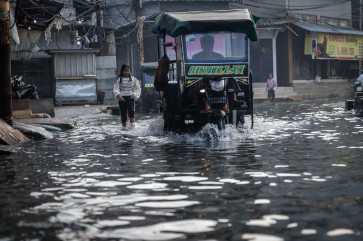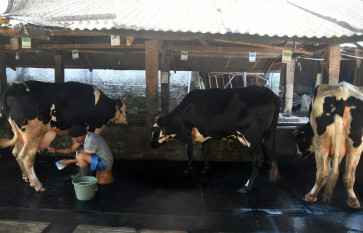Popular Reads
Top Results
Can't find what you're looking for?
View all search resultsPopular Reads
Top Results
Can't find what you're looking for?
View all search resultsCitizen journalism: The Bekantan experience: Habitat loss
Indonesia is filled with many unique animals that are endemic to the country
Change text size
Gift Premium Articles
to Anyone
Indonesia is filled with many unique animals that are endemic to the country. Orangutans and Komodo dragons are renowned examples of such creatures. However, there is another creature native to only a particular island in Indonesia, which has seemingly been forgotten, even by Indonesians themselves: the monyet bekantan, also known as the proboscis monkey.
The proboscis monkey is native only to Kalimantan island. Proboscis monkeys used to wander and roam through the mangrove forests of Kalimantan; however, the diminishing habitat has reduced their numbers to a few thousand.
In Banjarmasin, the capital city of South Kalimantan, tourists can take a boat ride along the waters to visit the many islands scattered around Kalimantan. One of the islands along the route is Kaget Island. The locals know Kaget Island as an excellent monkey-watching area. It was guaranteed that tourists would see monkeys thriving everywhere on the island.
According to the locals, there is a profusion of monkeys living there; three species of monkeys that have made Kaget Island their habitat, the proboscis monkey, the common monkey as well as the lutung Kalimantan. The reason for this was because the coasts of Kaget Island were thick with mangroves. Proboscis monkeys thrive in river areas with an abundance of trees. Areas with mangroves ' such as those along the coasts of Southern Kalimantan ' are ideal because the trees are dense and low to the water. Although they are adept swimmers, they still prefer the shelter of trees.
However upon arriving at the island, it became clear that it is impossible for monkeys to live in Kaget Island. The island is almost barren of trees. The trees left standing are those lining the perimeter of the island: A crude attempt at trying to hide the flattened land that locals have made into rice paddies. Many of the islands along the route have been flattened as well. There were very few trees, and the monkeys that have previously flourished there have been forced to find a new home.
Habitat loss, such as that on Kaget Island, is the most prominent cause of the decline of proboscis monkeys. This is happening all over Kalimantan; agriculture, forestry and urban development are rapidly reducing biodiversity. Indonesia is a big manufacturer of oil, wood and other resources essential to production.
For this reason, agriculture and industrial projects are common throughout the resource-producing areas of Indonesia, particularly Kalimantan. However the effects of this on the wildlife whose habitat is located in Kalimantan have not gone unnoticed. The number of proboscis monkeys in the last 5-10 years has dropped from over 20,000 to less than 7,000 left. A study on May 16, 2013, found there were only 5,907 individual proboscis monkeys left in the wild; the numbers are rapidly dropping. In 14 years, it is predicted that the proboscis monkey will be extinct.
Because of locals settling on Kaget Island, the monkeys have nowhere else to go. They are evicted from their natural habitat. Now, they are limited to only the remote areas of Kalimantan or small areas that still have dense trees, those that are not able to find a new home, die. Proboscis monkeys are a symbol of our culture. It is a unique animal that is endemic to our country. However there has been no movement for the conservation of these endangered animals.
Giovanna Aanisa Thohir and
Gabriella Alifa Thohir
Jakarta











